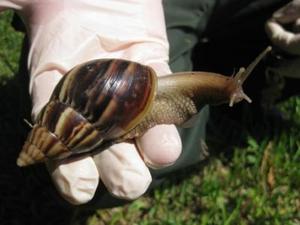Foreign invasionGiant snails invade Florida
South Florida has found itself in battle with a destructive invasive species known as the giant African land snail. The snail can grow as big as a rat and can eat plaster.

Huge African snails have invaded south Florida // Source: dailynews.co.th
South Florida has found itself in battle with a destructive invasive species known as the giant African land snail. The snail can grow as big as a rat and can eat plaster.
The Huffington Post reports that in Miami-Dade County, more than 1,000 of these mollusks are caught every week. Denise Feiber, a spokeswoman for Florida’s Department of Agriculture and Consumer Services, says that so far, more than 117,000 have been caught since they were first sighted by a homeowner in September 201.As the state’s rainy season is about the begin, residents will encounter the big snail even more often, as the snails emerge from their underground hibernation.
Feiber said that the snails attack “over 500 species of plants … pretty much anything that’s in their path and green.”
Experts met last week for a Giant African Land Snail Science Symposium to discussdifferent methods to eradicate the snails. One of the methods discussed was the use of stronger bait, which was recently approved by the federal government.
It is not known how the snail made it to Florida.
The Post notes that several Caribbean countries are overrun with the snails, which can cause tire blowouts in cars, and turn their shells into flying projectiles from lawnmower blades.
A typical snail can produce around 1,200 eggs per year and can be a nuisance around homes due to their attraction to stucco, which they eat for the calcium content needed in their shells. According to Feiber, the snail also carry a parasitic rat lungworm, which can cause illness in humans including meningitis, although no cases have been reported in the United States at this point.
In 1966, a boy returning from vacation in Hawaii brought three of the snails with him and his grandmother eventually released them in her garden. The population of the snails skyrocketed to 17,000 in just seven years. It took the state ten years and $1 million to destroy them
This is not the first non-native animal to invade Florida as many species are attracted to the subtropical climate. Recently the state had to deal with an infestation of Burmese pythons, which became established in the everglades in 2000.
